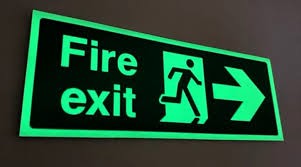Regulatory signs play a crucial role in maintaining safety, ensuring compliance with the law and guiding individuals in both workplace and public environments. Businesses in the UK must adhere to specific legal requirements when implementing regulatory signage, with key standards outlined in regulations such as the Health and Safety (Safety Signs and Signals) Regulations 1996 and BS EN ISO 7010. Understanding the most common regulatory signs is essential if you own a business to ensure legal compliance and workplace safety.

1. Health and Safety Signs
Workplace safety is a legal obligation for employers, and appropriate signage is a key component of a compliant safety strategy. Health and safety signs are generally categorised into four distinct types:
Mandatory Signs (blue and white) indicate actions that must be followed, such as “Wear Eye Protection” or “Keep Fire Door Closed.”
Prohibition Signs (red circle with a diagonal line) indicate forbidden actions, such as “No Smoking” or “No Entry.”
Warning Signs (yellow triangle with a black symbol) highlight potential hazards like “Caution: Wet Floor” or “Danger: High Voltage.”
Emergency Escape or First Aid Signs (green and white) indicate safety-related facilities such as fire exits, first aid stations, or emergency assembly points.
Compliance with these categories ensures consistency across workplaces to improve understanding and compliance for your employees and visitors.

2. Fire Safety and Emergency Exit Signs
Fire safety regulations require clear signage to guide occupants in an emergency. The Regulatory Reform (Fire Safety) Order 2005 mandates that businesses implement appropriate fire safety measures, including fire exit and evacuation signs.
Fire Exit Signs must be clearly visible and lead occupants to the nearest exit route. These are typically green and white and feature a running figure or directional arrows.
Fire Equipment Signs indicate the location of fire extinguishers, fire blankets, or hose reels, using red backgrounds with white symbols.
Fire Action Notices provide step-by-step instructions on what to do in the event of a fire and are often placed near fire alarms and exits.
Failure to display adequate fire safety signage can lead to legal penalties and increased risk during emergencies.
3. Traffic and Parking Signs
Businesses with private car parks, warehouses, or loading zones must display appropriate traffic management signs. These ensure safe movement for both vehicles and pedestrians.
Speed Limit and No Entry Signs control the flow of traffic and help prevent accidents.
Pedestrian Zone Signs indicate areas where vehicles are restricted, ensuring safety for employees and visitors.
Disabled Parking Signs reserve spaces for blue badge holders, ensuring compliance with the Equality Act 2010.
For businesses managing traffic on private premises, ensuring signage aligns with the Highway Code and local council regulations is essential.

4. Accessibility and Equality Compliance Signs
Under the Equality Act 2010, businesses must make reasonable adjustments to accommodate disabled individuals, which includes installing appropriate signage.
Accessible Toilets Signs indicate the location of disabled-friendly restrooms.
Hearing Loop System Signs notify hearing-impaired visitors of available assistive technology.
Braille and Tactile Signs help visually impaired individuals navigate buildings safely.
Providing clear and compliant accessibility signage demonstrates a commitment to inclusivity and prevents potential legal challenges.
5. Construction and Site Safety Signs
Construction sites are high-risk environments requiring strict safety signage. The Construction (Design and Management) Regulations 2015 stipulate that employers must provide clear safety instructions through appropriate signage.
Danger Signs warn of site hazards such as “Caution: Deep Excavation” or “Warning: Overhead Loads.”
Personal Protective Equipment (PPE) Signs instruct workers to wear hard hats, high-visibility vests, or other safety gear.
Restricted Access Signs prevent unauthorised personnel from entering hazardous areas.
Proper signage helps minimise accidents and ensures compliance with the Health and Safety Executive (HSE) regulations.
6. Food Hygiene and Catering Signs
Food businesses must adhere to hygiene regulations under the Food Standards Agency (FSA) and the Food Safety Act 1990. Appropriate signage in kitchens and catering areas is essential to safe food handling practices.
Handwashing Signs remind staff to wash hands before food preparation.
Allergen Awareness Signs alert staff and customers to potential food allergens.
Temperature Control Signs ensure proper storage and handling of perishable goods.
Restaurants, cafes, and food production facilities that fail to display hygiene-related signage risk non-compliance with food safety laws.
7. Electrical and Machinery Hazard Signs
Industrial and manufacturing environments require regulatory signage to mitigate electrical and machinery-related risks. The Electricity at Work Regulations 1989 and Provision and Use of Work Equipment Regulations 1998 outline safety measures for workplaces handling electrical and mechanical equipment.
High Voltage Warning Signs prevent contact with live electrical components.
Machine Guarding Signs indicate moving parts and potential entrapment risks.
Lockout/Tagout (LOTO) Signs inform workers about deactivated machinery to prevent accidental reactivation.
Employers in industrial sectors must ensure clear hazard signage is in place to maintain worker safety and legal compliance.
Ensuring Compliance and Best Practices
Displaying regulatory signage is not just about legal adherence. It also serves to improve efficiency in your workplace, reduces accidents and reassures visitors that a business prioritises safety. Your businesses should:
Conduct regular audits to ensure all signage is up-to-date and compliant with current UK regulations.
Use durable, weather-resistant materials for longevity, particularly for outdoor or industrial signs.
Place signs in highly visible locations and supplement with lighting where necessary.
Consider digital signage solutions for dynamic updates, especially in health and safety contexts.
Working with a professional signage provider such as FASTSIGNS® Manchester ensures that businesses install the correct signs to meet both legal requirements and operational needs.
Whether ensuring fire safety, workplace compliance, or accessibility, effective regulatory signage is a critical investment for any UK business. Get in touch with us today so we can help you ensure your regulatory signage covers all bases.